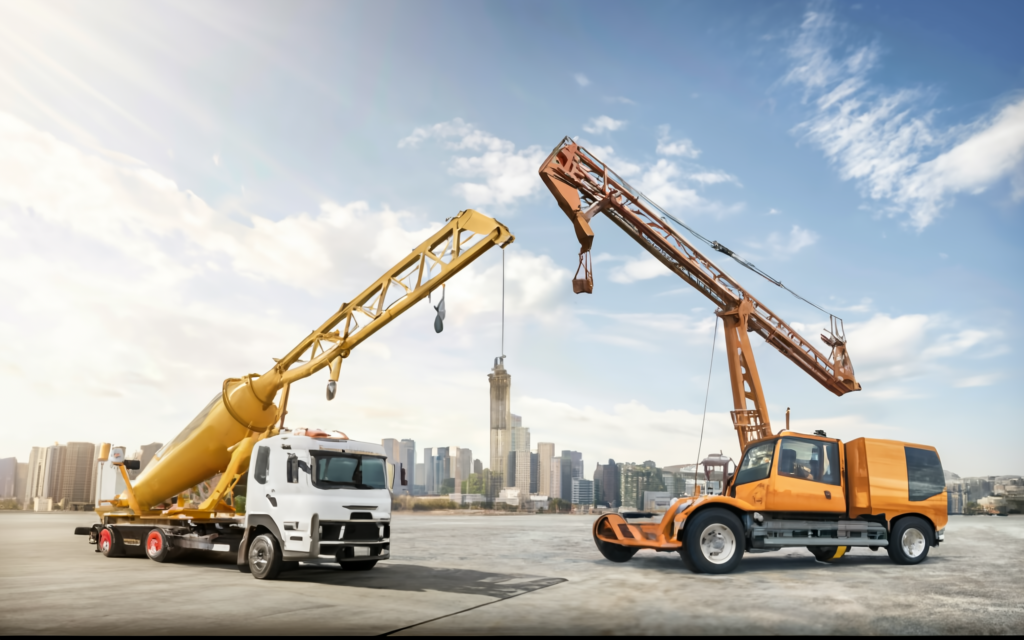When it comes to pouring concrete, the right equipment can make all the difference between a smooth operation and a logistical nightmare. Boom and concrete pumps are two important tools that play an important role in the concrete pouring process. Concrete boom pump hire may appear the same for you. While they both transport concrete they work very differently.
Boom Pumps 101
A boom pump is a truck-mounted concrete pump with an articulated robotic arm called the boom. This boom allows precise concrete placement at various locations on a job site.
Main Boom Pump Components:
- Truck/Trailer Base – Makes the pump mobile to transport between sites.
- Hydraulic Pump – Provides power to push concrete through the boom pipelines.
- Remote Control System – The operator uses a remote to control the boom movements.
- Outriggers – Stabilising legs that extend out for support during operation.
What is a Concrete Pump?
A concrete pump is a machine that pumps concrete through a system of pipelines from a central location. Unlike boom pumps, these are not self-propelled units. They require separate vehicles for transportation.
Concrete Pump Parts:
- Stationary Pump – Draws concrete and pumps it through the pipeline system.
- Rigid/Flexible Pipelines – Concrete gets transported via these pipelines.
- Short Placing Boom/Hose – Used for final, precise concrete placement after pipelines.
- External Power Source – Diesel/electric motor to power the pump since it’s not self-propelled.
Key Differences Between the Concrete and Boom Pump
A few of the main differences are given below:
Mobility:
Boom pumps are self-contained equipment that are easily transported from one construction site to another since they are placed on truck or trailer chassis. Boom pumps have exceptional mobility for moving around obstacles and into confined locations because of their truck-mounted design. Concrete pump hire, on the other hand, is stationary and requires separate vehicles to transport the pump unit and pipeline components to each new site.
Reach/Placement:
The main advantage of boom pumps is their articulated robotic arm or boom assembly. This multi-section hydraulic boom can extend upwards of 200 feet and rotate 360 degrees, providing unparalleled vertical reach and flexibility in concrete placement. Operators use a remote control to precisely maneuver the boom for accurate concrete delivery. In contrast, concrete pumps have more limited reach, typically using a shorter rigid boom or flexible hose at the end of the pipeline system.
Read More Articles: From Pages to Nature: The Birds Of America Book by Audubon
Capacity:
While boom pumps can handle significant volumes of concrete, their capacity is outmatched by concrete pumps. Concrete pumps feature larger, more powerful pump units designed to move higher volumes of concrete continuously through an extensive pipeline setup. Their ability to attach multiple pipeline extensions allows concrete to be pumped thousands of feet from the pump unit. As a result, they are ideal for large-scale projects requiring immense concrete quantities.
Setup Effort:
Boom pumps require a relatively quick and easy setup by simply deploying the hydraulic outriggers for stabilisation and unfolding the boom assembly. Concrete pumps involve more extensive site preparation, with crews painstakingly assembling the rigid pipeline sections or laying out long runs of flexible pipelines to reach the placement locations. This process is labor-intensive and time-consuming compared to boom pumps.
Precision/Control:
Due to the hydraulic remote control operation, boom pump operators have surgical-level precision and control when positioning the boom and placing concrete exactly where needed. The fixed pipeline setup of concrete pumps limits their concrete placement flexibility and precision once the pipes are configured on-site. However, they can still achieve accuracy at the end of the line.
Initial Investment
In general, boom pumps represent a larger upfront investment for contractors due to the complex design and engineering of the truck-mounted boom system components. Concrete pumps tend to be more affordable with their straightforward pump unit and pipeline design, though the pipeline investment adds up for big projects.
Applications of Boom Pumps
High-Rise Construction:
The boom pump’s signature feature, the hydraulic articulating boom, makes it ideally suited for high-rise construction projects. Operators can easily swing the boom around and extend it upwards to pump concrete vertically to elevated floor levels as the building rises.
Bridge Building:
Bridge construction requires strategically accessing areas under, around, and above the bridge deck and foundations. The boom pump’s maneuverability and reach allow concrete to be precisely placed in these difficult areas that typical pump lines cannot access.
Residential/Commercial:
For smaller residential and commercial construction projects like homes, offices, and retail buildings, boom pumps offer a compact footprint. They also provide the placement versatility needed to navigate through tight quarters on space-constrained job sites.
Read More Articles: Why is Q Florist the Go-To Flower Shop in NYC
Where You Can Use Concrete Pumps?
Large Infrastructure:
Massive infrastructure projects like dams, highways, and airport tarmacs require a steady supply of huge concrete volumes that only concrete pumps can satisfy. Their high-capacity pump units and nearly unlimited pipeline potential are essential.
Mass Pours:
Similar to infrastructure, concrete pumps are engineered to transport the extremely high concrete volumes needed for continuous slab, mat foundation, and other mass pour applications.
Underground Construction:
The ability to configure pipeline runs allows concrete pumps to deliver concrete below ground for projects such as:
- Basements
- Underground utilities
- Subway tunnels
- Mining operations
Remote Sites:
When construction takes place in distant or rough-terrain areas with poor access, concrete pumps can be staged nearby while miles of pipeline carry concrete from the pump unit to the location.
Final Thoughts
All in all, the nature of each project ultimately determines which pump makes more sense to use. Larger jobs with constant high-volume demand favor concrete pumps. However, smaller jobs with tough access points highlight boom pumps.
Concrete Pump Hire Near Me
At Pro-Mix Concrete, we understand the importance of efficiency and accuracy in the construction industry. Our fleet of trailer-mounted pumps, line pumps, and boom pumps is prepared to fulfill your demands whether you’re working on a residential, commercial, or industrial project.













